Gray Triggerfish
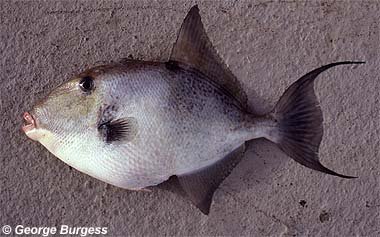
Balistes capriscus
When threatened, these distinctively shaped fish can slip into a small crevasse and erect their front dorsal spine, which locks it onto place, wedging them firmly into their hiding spot. They have sharp teeth for cutting into hard-shelled prey like sea urchins and starfish. They range from light- to olive- to brown-gray, with some banding, and can adjust their color to blend into their surroundings.
Order – Tetraordontiformes
Family – Balistidae
Genus – Balistes
Species – capriscus
Common Names
English language common names include gray triggerfish, grey triggerfish, filefish, leatherjacket, pig-faced, trigger-fish, triggerfish, common triggerfish, and turbot. Other language common names include balista (Rumanian), baliste (French), baliste cabri (French), ballesta (Spanish), cachua (Spanish), cangulo (Portuguese), escopeta (Spanish), khanzyr (Arabic), maracuguara (Portuguese), mola (Italian), mongarakawahagi (Japanese), ndor (Wolof), peixe-mola (Portuguese), pejepuerco blanco (Spanish), peje puerco (Spanish), penolera (Spanish), pesce palo (Italian), pez ballesta (Spanish), porco (Portuguese), puerco (Spanish), roncon (Spanish), sabaco (Spanish), schweinedruckerfisch (German), trekkervis (Dutch), tryckarfisk (Swedish), and varraco (Spanish).
Importance to Humans
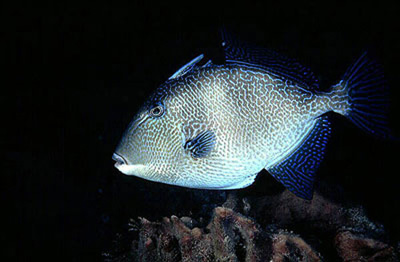
This triggerfish is a commercially and recreationally important fish. Flesh of the gray triggerfish is considered to be of excellent quality. It is consumed fresh, smoked, and dried/salted. It is also highly prized as a show fish in public aquarium facilities. Human consumption of the gray triggerfish has been linked to cases of ciguatera poisoning.
Conservation
At this time, the World Conservation Union (IUCN) does not consider the gray triggerfish to be vulnerable or threatened. The IUCN is a global union of states, governmental agencies, and non-governmental organizations in a partnership that assesses the conservation status of species.
Geographical Distribution
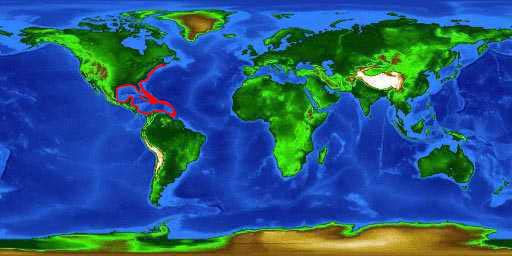
The gray triggerfish occurs in the western Atlantic Ocean from Nova Scotia (Canada), southeast to Bermuda, and south to Argentina, as well as in the Gulf of Mexico. It is common in the coastal waters of Florida. The gray triggerfish also found in the eastern Atlantic Ocean from England and Ireland, south to Angola, and in the Mediterranean Sea.
Habitat
Preferring hard bottoms, reefs, and ledges, the gray triggerfish is abundant in nearshore and offshore locations. This fish inhabits bays, lagoons, and seaward reefs to depths of 180 feet (55 m). The adults drift along the bottom either alone or in small groups, while the juveniles drift at the surface with sargassum.
Biology
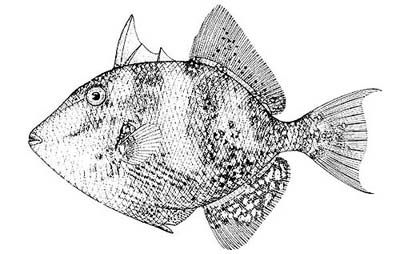
Distinctive Features
The body of the gray triggerfish is laterally compressed, with tough leathery skin and two dorsal fins. The triggerfish gets its common name from the spines on the dorsal fins. The first dorsal fin has three spines that can be locked into an erect position for use as predator-defense and as an anchoring device. The first spine is very strong and is connected in function with the second spine. When threatened, the triggerfish will dive into a tight crevice, wedging itself tightly and anchoring into place by erecting and locking the first spine. When the second spine is depressed its acts as a trigger, unlocking the first spine. The second dorsal fin is located directly opposite of an almost identical anal fin. The dorsal fins as the primary means of locomotion, are flapped back and forth in unison, propelling the fish through the water. The caudal fin lobes are elongate in large adults. Eyes of the gray triggerfish are located distant from the mouth. The scales on the front half of body are large and plate-like while the scales on the posterior are smooth. There are one or more enlarged scales located behind the gill opening. Small opercula are located directly above the pectoral fins. The pectoral fin is short and rounded and the dorsal fins are separate.
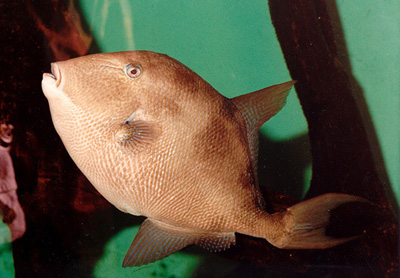
Coloration
Juvenile gray triggerfish are yellowish with small violet dots. At lengths less than 50 mm, large, irregular dark patches form on the body and the fins are tinted with yellow, blue, and olive or the second dorsal, anal, and caudal fin membranes are translucent. Saddle markings interspersed with light spots also appear on the dorsal and anal fins.
The primary body color of adult gray triggerfish is light gray to olive-gray to yellowish-brown. This fish appears dull gray while swimming in open waters, however it has the ability to change its coloration slightly to match other surroundings. There are three faint broad dark blotches on upper body and often white dots and lines on the lower body and fins. Blue spots and lines are located on the upper body and dorsal fin. There is a pale narrow band on the chin and the upper rim of the eye is blue. The dorsal and anal fins appear marbled in color. Gray triggerfish fade in color as they age.
Dentition
The mouth is small with strong jaws that contain eight strong incisor-like specialized teeth used to chisel holes of hard-shelled prey items.
Size, Age & Growth
This triggerfish can weigh up to 13 pounds (5.9 kg) and grow to a maximum length of approximately 30 inches (76 cm). Sexual maturity is reached at 2 years of age, measuring 12 inches (30 cm) in length at first spawning. The maximum age of triggerfish is believed to be approximately 13 years.
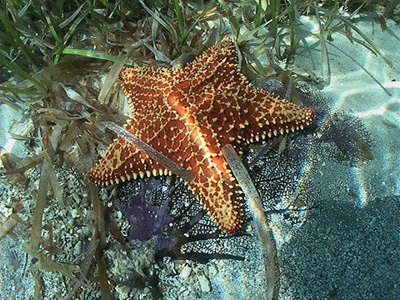
Food Habits
As a diurnal predator, the gray triggerfish feeds primarily on benthic invertebrates such as shrimp, crabs, sea urchins, sand dollars, sea stars, sea cucumbers, and bivalve mollusks. During one study, triggerfish were observed displaying an interesting feeding behavior. They moved away from their reef home, out over sand, and assumed a vertical position a few inches above the bottom. The fish directed a stream of water at the sand with enough force to reveal sand dollars living below the surface. If none were present, the fish moved about three feet away and continued this behavior. When the triggerfish was successful at exposing a sand dollar, it repeated the blowing action, further exposing the prey. Next, the triggerfish darted in, grabbing the sand dollar with its beak-like teeth, lifting it above the bottom and dropping it. This process was repeated until the sand dollar landed upside down. This was followed by the triggerfish assuming a vertical position over the sand dollar, and with jaws closed, thrusting downward, crushing the center. The fish then ate the soft inside tissues of the sand dollar. Triggerfish also locate and eat sea urchins in a similar manner. Juvenile triggerfish associated with sargassum communities feed on algae, hydroids, barnacles, and polychaetes.
Reproduction
During July through September after water temperatures reach 70°F (21°C), gray triggerfish build their nests on the bottom substrate. Between 50,000 and 100,00 eggs, depending upon the size of the female, are laid in a hollow nest scooped out of the sand. Polygamous mating between males and females is largely random with no long-term pair bonding. The adult triggerfish guard the nest from potential predators, including divers, if they approach the nest too closely. Wrasses and red snappers have been observed taking eggs from the nests of gray triggerfish. The eggs that survive predation hatch within 48-55 hours. After hatching, the juveniles leave the nest and head to the surface of the water. At the surface, they often associate with sargassum communities. Sargassum is a floating seaweed usually found in clear blue water. Entire communities are closely associated with this sargassum, with the young triggerfish among the eight vertebrate species found there. The amount of sargassum varies greatly from year to year. High survival rates of young triggerfish are often correlated with high sargassum production. As the autumn months approach, the juvenile triggerfish leave the sargassum habitat for bottom reef habitats at lengths of 5-7 inches (12.7-17.8 cm).
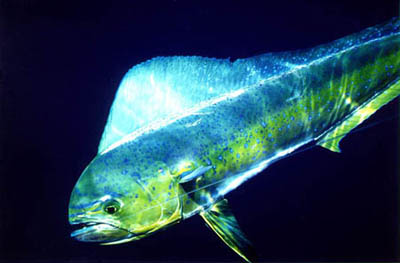
Predators
Tuna, dolphinfish, marlin, sailfish and sharks prey upon juvenile gray triggerfish while amberjack, grouper, and sharks are known to prey upon the adults.
Taxonomy
The gray triggerfish was originally described by the German naturalist Johann Friedrich Gmelin in 1788 who named it Balistes carolinensis. The name was later revised to Balistes capriscus. Synonyms include B. forcipatus Gmelin 1788, B. spilotopterygius Walbaum 1792, B. buniva Lacepede 1803, B. caprinus Valenciennes 1836, B. fuliginosus DeKay 1842, B. taeniopterus Poey 1860, B. powellii Cope 1870, and B. moribundus Cope 1871. These final two synonyms were originally used to describe individuals that were both juveniles of B. capriscus.
Prepared by: Cathleen Bester